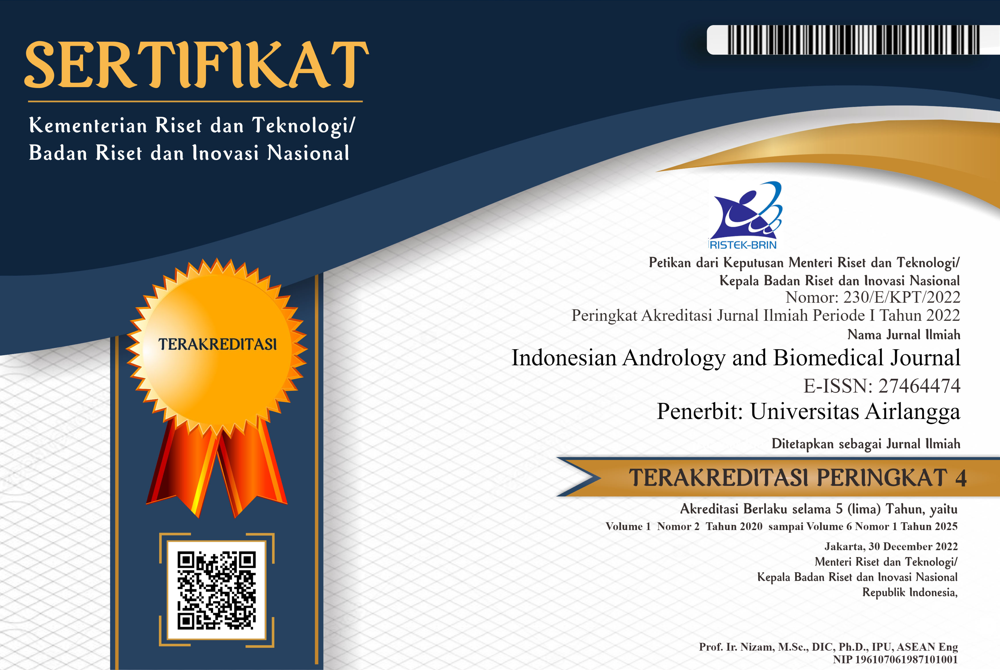The Correlation between Hypogonadism and Coronary Heart Disease in Men at RSUP Prof. Ngoerah
Downloads
Hypogonadism is a clinical syndrome associated with aging, characterized by low levels of testosterone in a man's body. Hypogonadism can lead to various diseases, one of which is coronary heart disease. Coronary heart disease is a cardiovascular disease caused by the buildup of plaque in the coronary arteries. This research aims to examine the relationship between hypogonadism and coronary heart disease in men at RSUP Prof. Ngoerah. The research was conducted analytically with a case-control design. Hypogonadism was measured using the ADAM score questionnaire, which consists of 10 questions. The research sample comprised men who were coronary heart disease patients and men who were non-coronary heart disease patients aged 35–45 years in the Gedung Pelayanan Jantung Terpadu RSUP Prof. Ngoerah. The sample was determined using a consecutive sampling technique, with a total of 50 participants. The research results found that 28 participants (56%) tested positive for hypogonadism, and 22 participants (44%) tested negative for hypogonadism. A p-value of 0.004 indicated a significant relationship (p ≤ 0.05) between hypogonadism and coronary heart disease. The calculated Odds Ratio (OR 95% CI) between hypogonadism and coronary heart disease was 5.6 (1.648 – 19.232).Among the research participants, 19 (76%) were both positive for hypogonadism and coronary heart disease. Meanwhile, 16 participants (64%) were negative for both hypogonadism and coronary heart disease. The lower the testosterone levels in men, the higher the risk of developing coronary heart disease. Coronary heart disease patients with hypogonadism were 5.6 times more likely to have the condition compared to those without hypogonadism. There is a significant correlation between andropause and coronary heart disease in men at RSUP Prof. Ngoerah.
REFERENCES
Melyani, M., Tambunan, L. N., and Baringbing, E. P. (2023). “Hubungan Usia dengan Kejadian Penyakit Jantung Koroner pada Pasien Rawat Jalan di RSUD dr. Doris Sylvanus Provinsi Kalimantan Tengah”. In Jurnal Surya Medika (Vol. 9, Issue 1, pp. 119–125). https://doi.org/10.33084/jsm.v9i1.5158.
Lunenfeld, B., Mskhalaya, G., Zitzmann, M., Arver, S., Kalinchenko, S., Tishova, Y., and Morgentaler, A. (2015). "Recommendations on the Diagnosis, Treatment and Monitoring of Hypogonadism in Men". Aging Male, 18(1), 5–15. doi: https://doi.org/10.3109/13685538.2015.1004049.
Decroli, E. (2018). "Testosteron and The Benefit for Men’s Health". Bagian Ilmu Penyakit Dalam Fak. Kedokteran Unand/ RSUP Dr. M. Djamil Padang, 51(1), 51.
Ko, D. H., Kim, S. E., and Lee, J. Y. (2021). "Prevalence of Low Testosterone According to Health Behavior in Older Adults Men". Healthcare (Switzerland), 9(1), 1–9. doi: https://doi.org/10.3390/healthcare9010015.
Rachman, S. (2016). "Bab II Kajian Pustaka. Late Onset Hypogonadism (LOH), Juga Dikenal Sebagai Sindrom Defisiensi". 4(1), 1–23.
Salonia, A., Rastrelli, G., Hackett, G., Seminara, S. B., Huhtaniemi, I. T., Rey, R. A., Hellstrom, W. J. G., Palmert, M. R., Corona, G., Dohle, G. R., Khera, M., Chan, Y. M., and Maggi, M. (2019). "Paediatric and Adult-Onset Male Hypogonadism". Nature Reviews. Disease Primers, 5(1), 38. doi: https://doi.org/10.1038/S41572-019-0087-Y.
Goodale, T., Sadhu, A., Petak, S., and Robbins, R. (2017). "Testosterone and the Heart". Methodist DeBakey Cardiovascular Journal, 13(2), 68–72. doi: https://doi.org/10.14797/MDCJ-13-2-68.
Santosa, W. N., and Baharuddin, B. (2020). "Penyakit Jantung Koroner dan Antioksidan". KELUWIH: Jurnal Kesehatan Dan Kedokteran, 1(2), 98–103. doi: https://doi.org/10.24123/kesdok.v1i2.2566.
Erawati, A. D. (2021). "Peningkatan Pengetahuan tentang Penyakit Jantung Koroner". Jurnal ABDIMAS-HIP: Pengabdian Kepada Masyarakat, 2(1), 6–9. doi: https://doi.org/10.37402/abdimaship.vol2.iss1.113.
Malakar, A. K., Choudhury, D., Halder, B., Paul, P., Uddin, A., and Chakraborty, S. (2019). "A Review on Coronary Artery Disease, Its Risk Factors, and Therapeutics". Journal of Cellular Physiology, 234(10), 16812–16823. doi: https://doi.org/10.1002/jcp.28350.
Alwani, M., Yassin, A., Talib, R., Al-Qudimat, A., Aboumarzouk, O., Al-Zoubi, R. M., Saad, F., Haider, K. S., and Ansari, A. Al. (2021). "Cardiovascular Disease, Hypogonadism and Erectile Dysfunction: Early Detection, Prevention and the Positive Effects of Long-Term Testosterone Treatment: Prospective Observational, Real-Life Data". Vascular Health and Risk Management, 17(August), 497–508. doi: https://doi.org/10.2147/VHRM. S309714.
Morris, P. D., and Channer, K. S. (2012). "Testosterone and Cardiovascular Disease in Men”. Asian Journal of Andrology, 14(3), 428–435. doi: https://doi.org/10.1038/aja.2012.21.
Melyani, M., Tambunan, L. N., and Baringbing, E. P. (2023). “Hubungan Usia dengan Kejadian Penyakit Jantung Koroner pada Pasien Rawat Jalan di RSUD dr. Doris Sylvanus Provinsi Kalimantan Tengah”. In Jurnal Surya Medika (Vol. 9, Issue 1, pp. 119–125). doi: https://doi.org/10.33084/jsm.v9i1.5158.
Tampubolon, L. F., Ginting, A., and Saragi Turnip, F. E. (2023). “Gambaran Faktor yang Mempengaruhi Kejadian Penyakit Jantung Koroner (PJK) di Pusat Jantung Terpadu (PJT)”. In Jurnal Ilmiah Permas: Jurnal Ilmiah STIKES Kendal (Vol. 13, Issue 3, pp. 1043–1052). doi: https://doi.org/10.32583/pskm.v13i3.1077.
Gibran, M. S., & Nurulhuda, U. (2023). Hubungan Obesitas Dengan Kejadian Penyakit Jantung Koroner. In JHCN Journal of Health and Cardiovascular Nursing (Vol. 3, Issue 2, pp. 57–62).
Sriwahyuni. (2023). “Hubungan Aktifitas Fisik, Kebiasaan Merokok dan Hipertensi terhadap Penyakit Jantung Koroner”. In Journal of Nursing Education and Practice (Vol. 3, Issue 1, pp. 18–25). doi: https://doi.org/10.53801/jnep.v3i1.181.
Li, H., and Xia, N. (2023). “Alcohol and The Vasculature: A Love-Hate Relationship?”. In Pflugers Archiv European Journal of Physiology (Vol. 475, Issue 7, pp. 867–875). doi: https://doi.org/10.1007/s00424-023-02818-8.
Alpert, J. S. (2023). “New Coronary Heart Disease Risk Factors”. In American Journal of Medicine (Vol. 136, Issue 4, pp. 331–332). doi: https://doi.org/10.1016/j.amjmed.2022.08.002.
Selim, S., Lona, H., Imran, S., Rahman, M., Mahjabeen, S., and Mustari, M. (2022). “Frequency and Determinants of Hypogonadism and Erectile Dysfunction in Men with Newly Detected Type 2 Diabetes”. doi: https://doi.org/10.4103/bjem.bjem_2_22.
Holt, P. R., Altayar, O., and Alpers, D. H. (2023). “Height with Age Affects Body Mass Index (BMI) Assessment of Chronic Disease Risk”. In Nutrients (Vol. 15, Issue 21). doi: https://doi.org/10.3390/nu15214694.
Spaziani, M., Carlomagno, F., Tarantino, C., Angelini, F., Vincenzi, L., and Gianfrilli, D. (2023). “New Perspectives in Functional Hypogonadotropic Hypogonadism: Beyond Late Onset Hypogonadism.” Frontiers in Endocrinology (Vol. 14). doi: https://doi.org/10.3389/fendo.2023.1184530.
Tang, L., Chen, M., Li, J., Xu, X., and Puc, X. (2024). “Association of Testosterone with Myocardial Infarction and Severity of Coronary Artery Disease Among Male Patients”. doi: https://doi.org/10.1016%2Fj.ijcrp.2024.200281.
Corona, Giovanni, Rastrelli, G., Monami, M., Guay, A., Buvat, J., Sforza, A., Forti, G., Mannucci, E., and Maggi, M. (2011). “Hypogonadism As A Risk Factor for Cardiovascular Mortality in Men: A Meta-Analytic Study”. doi: https://doi.org/https://doi.org/10.1530/eje-11-0447.
Copyright (c) 2024 Jovita Theodora Liu, I Gusti Ngurah Pramesemara, I Made Putra Swi Antara, Ida Ayu Dewi Wiryanthini

This work is licensed under a Creative Commons Attribution-ShareAlike 4.0 International License.

















